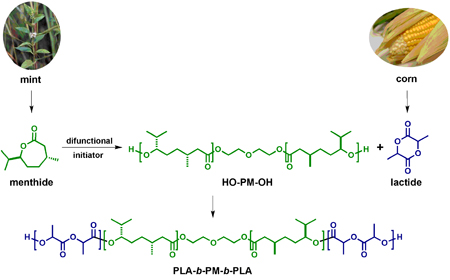10/3/2007
Green Thermoplastic Elastomers
Recent Research from the groups of Professors Marc
Hillmyer and William
Tolman.
The
development of new polymeric materials from renewable resources is gaining
considerable attention. These materials can act as environmentally friendly
replacements for commodity plastics that contain petrochemical starting
materials. The low cost and ready availability of starting materials from
renewable resources can allow biorenewable polymers to be competitive with
current commercial plastics. Polylactide (PLA) is one of the more attractive
biodegradable polyesters because of the availability of lactic acid and
the nontoxicity, hydrolyzability, and biocompatibility of the homopolymer.
Unfortunately, under tension PLA fractures at very low strains (ca. 3%),
and is therefore unsuitable for use in numerous applications where elasticity
and ductility are essential.

With
the aim of enhancing the utility of polylactide, graduate student Carolyn
Wanamaker and Professors Marc Hillmyer and William Tolman have been exploring
all biorenewable ABA triblock copolymers as tough alternatives to PLA.
To do this, they incorporated polymenthide (PM), a new biorenewable polymer
developed at Minnesota derived from menthol (Zhang,
C.; Hillmyer, M. A.; Tolman, W. B. Biomacromolecules 2005, 6,
2091–2095), as the soft B block in an ABA triblock copolymer
with PLA (A) end blocks. A series of these triblock copolymers were prepared
with varying composition by the ring-opening polymerization of menthide
using a difunctional initiator, diethylene glycol, giving the difuctional
macroinitiator HO-PM-OH, followed by the ring-opening polymerization of
lactide to yield the desired PLA-b-PM-b-PLA triblock copolymer (see Figure).
The all biorenewable ABA triblock copolymers exhibited both good strength
and elasticity. Furthermore, these materials demonstrated impressive elongations
(nearly 10x the original length) that were comparable to commercial, fossil
fuel derived, thermoplastic elastomers (TPEs). These materials also showed
impressive recovery or “true elasticity” upon subjecting the sample to
multiple cycles of loading and unloading at a strain of 300%. These results
demonstrate that PLA-b-PM-b-PLA
triblock copolymers are potentially suitable for numerous applications
in the biomedical and pharmaceutical fields.
Their
results will soon appear in the American Chemical Society journal Biomacromolecules.
|